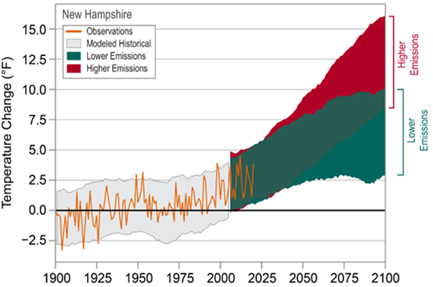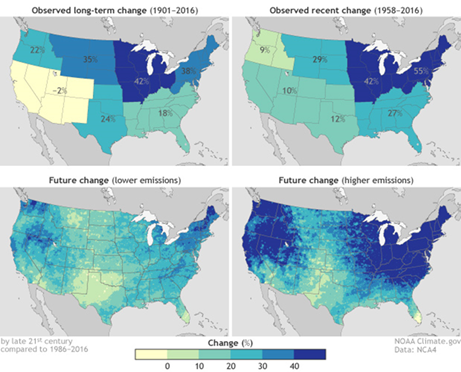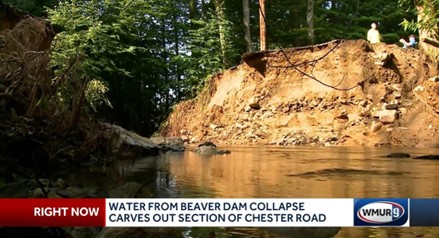Climate Data and Impacts
We live on a rapidly warming planet. The Earth is in the midst of a “great acceleration” in terms of temperature rise. Mean global surface temperatures have increased by more than 1°Celsius (or almost 2° Fahrenheit) relative to the 1850-1900 average, and are projected to continue increasing rapidly.[1]
Rising temperatures
The extent of future temperature rise will be largely contingent on the effectiveness of efforts to reduce and remove greenhouse gases (GHG) from the atmosphere. Since climate scientists cannot fully predict the impact of collective climate efforts, forward-looking projections are often shown according to “lower emissions” or “higher emissions” scenarios. By the end of the century, projected warming will contribute to a mean NH temperature that is several degrees hotter than today. The outcome will depend on how much local and global emissions can be curbed.
Observed and projected temperature change in New Hampshire

When it rains, it pours
As temperatures rise, air can hold more moisture, resulting in higher levels of precipitation and greater frequency of extreme precipitation events that substantially exceed normal rates. With temperatures warming by 2°C (or about 3.6°F), heavy rain events will become 1.7 times more likely, and 14% more intense.[1] As the following maps indicate, the Northeastern US has already seen a dramatic increase in extreme precipitation in the 20th century, and the pattern is expected to continue throughout the 21st century. (See Figure 1.3.) In fact, in 2023, every state in New England experienced one of their top 10 wettest summers, while New Hampshire and Vermont saw their wettest summers on record.[2]
Change in extreme precipitation across the United States

Consequences for our region
The greatest climate threat currently facing the SNHPC region is inland flooding due to extreme precipitation events. Flooding in NH regularly washes out infrastructure, damages the economy and ecology, and can threaten the health and safety of residents. While climate change is increasing risks related to a variety of natural hazards – including drought and extreme temperatures – according to the NH Department of Environmental Services, flooding is the state’s most common and costly natural disaster.[1]
Lane Road in Chester, July 2023
[1] See UCAR Center for Science Foundation, “Predictions of Future Global Climate.”
[1] See Intergovernmental Panel on Climate Change, 2021 Summary for Policymakers.


